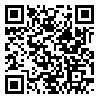مجله رویش روانشناسی از دادن گواهیهای کاغذی معذور است. لطفا تقاضا نکنید. همه گواهی ها در صفحه شخصی کاربران موجود است.
year 14, Issue 6 (summer 2025 2025)
Rooyesh 2025, 14(6): 121-130 |
Back to browse issues page
Download citation:
BibTeX | RIS | EndNote | Medlars | ProCite | Reference Manager | RefWorks
Send citation to:



BibTeX | RIS | EndNote | Medlars | ProCite | Reference Manager | RefWorks
Send citation to:
Chamani M, Aghaei H, Taher M, Tabatabaee S M. (2025). Comparison of the effectiveness of Emotion efficacy therapy and Exposure and Response prevention on emotional dysregulation of people with obsessive-compulsive disorder. Rooyesh. 14(6), 121-130.
URL: http://frooyesh.ir/article-1-5812-en.html
URL: http://frooyesh.ir/article-1-5812-en.html
1- PhD Student, Department of General Psychology, Shahrood Branch, Islamic Azad University, Shahrood, Iran.
2- Assistant Professor, Department of Psychology, Shahrood Branch, Islamic Azad University, Shahrood, Iran. ,h.aghaei@iau-shahrood.ac.ir
3- Associate Professor, Department of Psychology, Shahrood Branch, Islamic Azad University, Shahrood, Iran.
4- Assistant Professor, Department of cognitive sciences, Semnan University, Semnan, Iran.
2- Assistant Professor, Department of Psychology, Shahrood Branch, Islamic Azad University, Shahrood, Iran. ,
3- Associate Professor, Department of Psychology, Shahrood Branch, Islamic Azad University, Shahrood, Iran.
4- Assistant Professor, Department of cognitive sciences, Semnan University, Semnan, Iran.
Abstract: (680 Views)
The present study aimed to compare the effects of emotion efficiency and response exposure/inhibition therapies on emotional dysregulation of people with obsessive-compulsive disorder. The method of this study was quasi-experimental with a pre-test-post-test design and a 2-month follow-up. The statistical population of the research was all men and women who were referred to the counseling and psychotherapy centers under the supervision of the Psychology and Counseling System Organization in District 3 of Tehran in the fall of 2022 and received a definitive diagnosis of obsessive-compulsive disorder by a psychiatrist. 51 people were included in the study using a non-random sampling method purposefully and were randomly divided into two experimental groups and a control group. Then, the first experimental group (emotional efficiency therapy) and the second experimental group (response exposure/inhibition therapy) were intervened during 12 1-hour sessions a week. The study tools included the Yale-Brown Obsessive-Compulsive Scale (Y-BOCS, Goodman et al., 1989) and cognitive emotion regulation questionnaires (CERQ, Garnefski & Kraaij, 2006). Data analysis using repeated measurement tests and Bonferroni's post hoc test showed that both treatments significantly decreased emotional dysregulation compared to the control group (P< 0.01), and there was no significant difference between the effects of the two methods (P> 0.01). Thus, an important step can be taken in reducing the consequences caused by the lack of emotional dysregulation in OCD by using any of the emotion efficiency and response exposure/inhibition therapies for emotional dysregulation.
Keywords: Emotional Dysregulation, Exposure and Response Prevention, Obsessive-Compulsive Disorder, Emotion Efficacy Therapy.
Type of Article: Research |
Subject:
Clinical Psychology
Received: 2024/11/20 | Accepted: 2024/12/24 | ePublished: 2025/08/28
Received: 2024/11/20 | Accepted: 2024/12/24 | ePublished: 2025/08/28
Send email to the article author
| Rights and permissions | |
 |
This work is licensed under a Creative Commons Attribution-NonCommercial 4.0 International License. |





